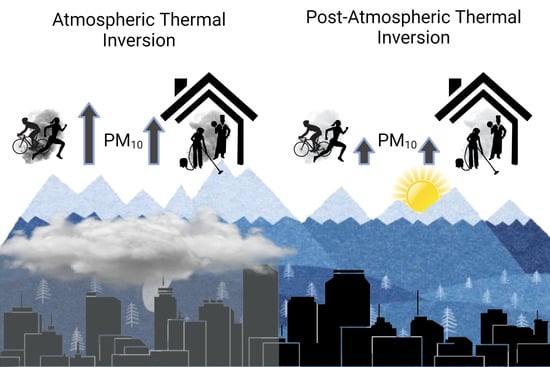Assessment of Individual-Level Exposure to Airborne Particulate Matter during Periods of Atmospheric Thermal Inversion
Abstract
1. Introduction
2. Materials and Methods
2.1. Collecting Particulate Matter Data
2.2. Determining ATIs
2.3. Treatment of Data from the PPMs and TADs
- -
- Outdoor activities in the TAD were: using a bicycle, walking, running outdoors, participating in outdoor sports activities, and three generic labels: “Home.OUT”, “Office.OUT”, and “Other.OUT”. For indoor activities, there were similar generic labels included, “Home.IN”, “Office.IN”, and “Other.IN”, as well as resting and sleeping indoors, playing, indoor sporting activities, cooking, cleaning, and smoking indoors. More specific activities were included in the generic labels;
- -
- Primarily, activity and microlocation labels from the TADs were used to determine if the person was indoors or outdoors. To further refine the accuracy of the indoor/outdoor variable, ambient temperature data recorded by the PPM were used;
- -
- During the observed period from late February to early March in 2019, the outdoor temperatures as measured by AWS-B never exceeded 19 °C in Ljubljana. Using this value as the highest base value gave an approximate highest possible temperature for outdoor activities, though it did have some drawbacks as the device could be exposed to direct sunlight and show higher values than those recorded at automatic weather stations;
- -
- The PPM was collocated with a reference instrument (Testo SE & Co. KGaA, Lenzkirch, Germany, Testo 435-2 sensor with an external IAQ probe [39]) to assess the accuracy of the temperature measurements. Results showed that the PPM had a very high correlation (0.98) with the values recorded by the reference instrument, though the values consistently showed 4.5 °C higher values than the reference instrument. Though the PPM had precise values, they were not accurate. There are several possible causes, most probably due to the positioning of the sensor enclosed in the device close to a warm rechargeable battery. Temperature difference was even higher during the first half hour of charging the battery. This does not affect the outdoor measurements as it is reasonable to assume that the device was not charged during outdoor activities;
- -
- Considering the above (the temperature in Ljubljana never exceeding 19 °C and the 4.5 °C (offset) higher values of the PPM), activities were removed from the outdoor category if they had a temperature above 23.5 °C, and similarly removed from the indoor category if the temperatures were below 23.5 °C.
2.4. Data Selection and Evaluation
3. Results and Discussion
3.1. ATIs
Estimate of Boundary Layer Height
3.2. PM Measurements at the Monitoring Station
3.3. Data Collected from PPMs and TADs
3.4. Exposure Assessment
4. Limitations
5. Conclusions
- Periods with persistent ATIs present a fitting opportunity to assess the applicability of personal monitors to capture the spatiotemporal variability of indoor and outdoor exposure. A clear distinction in terms of PM concentrations between the two periods provides an opportunity to observe how high-exposure events can influence cumulative exposure;
- Exposure to PM10 is higher during periods with persistent ATIs, when ambient concentrations increase due to specific meteorological conditions. This is evident indoors and outdoors and for almost all activities, except for a few that are mainly influenced by the PM10 associated with the respective activity. Indoor concentrations are lower than the outdoor concentrations during the period with ATIs, though they are still higher than indoor and outdoor concentrations in the post-ATI period;
- Using activity data enables an individual-level scale analysis of exposure and illustrates that the influence of activities on exposure indoors should not be disregarded when assessing cumulative exposure. Activities can directly, e.g., cooking and cleaning, or indirectly reduce air quality, e.g., opening a window during a period with poor outdoor air quality;
- Measuring exposure on an individual level is necessary to capture high-exposure events in microlocations. These results showed that several high-exposure events can greatly raise exposure levels. Additionally, personal monitors can detect trends and show how specific routines influence exposure;
- These measurements confirm that there are high levels of exposure indoors even in high-income countries that mostly don’t use solid fuels for cooking and heating. A better understanding of activity-specific exposure could provide a basis for policies that can more accurately address exposure to poor air quality.
Author Contributions
Funding
Institutional Review Board Statement
Informed Consent Statement
Data Availability Statement
Acknowledgments
Conflicts of Interest
References
- Anenberg, S.C.; Achakulwisut, P.; Brauer, M.; Moran, D.; Apte, J.S.; Henze, D.K. Particulate Matter-Attributable Mortality and Relationships with Carbon Dioxide in 250 Urban Areas Worldwide. Sci. Rep. 2019, 9, 11552. [Google Scholar] [CrossRef] [PubMed]
- Pope, C.A.; Ezzati, M.; Dockery, D.W. Fine-Particulate Air Pollution and Life Expectancy in the United States. N. Engl. J. Med. 2009, 360, 376–386. [Google Scholar] [CrossRef] [PubMed]
- Kim, S.-Y.; Pope, A.C.; Marshall, J.D.; Fann, N.; Sheppard, L. Reanalysis of the Association between Reduction in Long-Term PM2.5 Concentrations and Improved Life Expectancy. Environ. Health 2021, 20, 102. [Google Scholar] [CrossRef] [PubMed]
- Gutman, L.; Pauly, V.; Orleans, V.; Piga, D.; Channac, Y.; Armengaud, A.; Boyer, L.; Papazian, L. Long-Term Exposure to Ambient Air Pollution Is Associated with an Increased Incidence and Mortality of Acute Respiratory Distress Syndrome in a Large French Region. Environ. Res. 2022, 212, 113383. [Google Scholar] [CrossRef]
- Wu, Y.; Wang, W.; Liu, C.; Chen, R.; Kan, H. The Association between Long-Term Fine Particulate Air Pollution and Life Expectancy in China, 2013 to 2017. Sci. Total Environ. 2020, 712, 136507. [Google Scholar] [CrossRef] [PubMed]
- Directive 2008/50/EC of the European Parliament and of the Council of 21 May 2008 on Ambient Air Quality and Cleaner Air for Europe; EEA: Copenhagen, Denmark, 2008; Volume 152.
- de Ferreyro Monticelli, D.; Santos, J.M.; Goulart, E.V.; Mill, J.G.; da Silva Corrêa, J.; dos Santos, V.D.; Reis, N.C. Comparison of Methods for Assessment of Children Exposure to Air Pollution: Dispersion Model, Ambient Monitoring, and Personal Samplers. Air Qual. Atmos. Health 2022, 15, 645–655. [Google Scholar] [CrossRef]
- Park, Y.M.; Kwan, M.-P. Individual Exposure Estimates May Be Erroneous When Spatiotemporal Variability of Air Pollution and Human Mobility Are Ignored. Health Place 2017, 43, 85–94. [Google Scholar] [CrossRef]
- Menon, J.S.; Nagendra, S.M.S. Personal Exposure to Fine Particulate Matter Concentrations in Central Business District of a Tropical Coastal City. J. Air Waste Manag. Assoc. 2018, 68, 415–429. [Google Scholar] [CrossRef]
- Georgiadis, P.; Stoikidou, M.; Topinka, J.; Kaila, S.; Gioka, M.; Katsouyanni, K.; Sram, R.; Kyrtopoulos, S.A. Personal Exposures to PM(2.5) and Polycyclic Aromatic Hydrocarbons and Their Relationship to Environmental Tobacco Smoke at Two Locations in Greece. J. Expo. Anal. Environ. Epidemiol. 2001, 11, 169–183. [Google Scholar] [CrossRef]
- Choi, H.; Perera, F.; Pac, A.; Wang, L.; Flak, E.; Mroz, E.; Jacek, R.; Chai-Onn, T.; Jedrychowski, W.; Masters, E.; et al. Estimating Individual-Level Exposure to Airborne Polycyclic Aromatic Hydrocarbons throughout the Gestational Period Based on Personal, Indoor, and Outdoor Monitoring. Environ. Health Perspect. 2008, 116, 1509–1518. [Google Scholar] [CrossRef]
- Mohammed, M.O.A.; Song, W.-W.; Ma, W.-L.; Li, W.-L.; Ambuchi, J.J.; Thabit, M.; Li, Y.-F. Trends in Indoor–Outdoor PM2.5 Research: A Systematic Review of Studies Conducted during the Last Decade (2003–2013). Atmos. Pollut. Res. 2015, 6, 893–903. [Google Scholar] [CrossRef]
- Dessimond, B.; Annesi-Maesano, I.; Pepin, J.-L.; Srairi, S.; Pau, G. Academically Produced Air Pollution Sensors for Personal Exposure Assessment: The Canarin Project. Sensors 2021, 21, 1876. [Google Scholar] [CrossRef] [PubMed]
- Jerrett, M.; Burnet, R.T.; Ma, R.; Pope, C.A.I.; Krewski, D.; Newbold, B.; Thurston, G.; Shi, Y.; Finkelstein, N.; Calle, E.E.; et al. Spatial Analysis of Air Pollution and Mortality in Los Angeles. Epidemiology 2006, 17, S69. [Google Scholar] [CrossRef]
- Tsou, M.-C.M.; Lung, S.-C.C.; Shen, Y.-S.; Liu, C.-H.; Hsieh, Y.-H.; Chen, N.; Hwang, J.-S. A Community-Based Study on Associations between PM2.5 and PM1 Exposure and Heart Rate Variability Using Wearable Low-Cost Sensing Devices. Environ. Pollut. 2021, 277, 116761. [Google Scholar] [CrossRef] [PubMed]
- Liang, L.; Gong, P.; Cong, N.; Li, Z.; Zhao, Y.; Chen, Y. Assessment of Personal Exposure to Particulate Air Pollution: The First Result of City Health Outlook (CHO) Project. BMC Public Health 2019, 19, 711. [Google Scholar] [CrossRef] [PubMed]
- Niedźwiedź, T.; Łupikasza, E.B.; Małarzewski, Ł.; Budzik, T. Surface-Based Nocturnal Air Temperature Inversions in Southern Poland and Their Influence on PM10 and PM2.5 Concentrations in Upper Silesia. Appl. Clim. 2021, 146, 897–919. [Google Scholar] [CrossRef]
- Tunno, B.J.; Michanowicz, D.R.; Shmool, J.L.C.; Kinnee, E.; Cambal, L.; Tripathy, S.; Gillooly, S.; Roper, C.; Chubb, L.; Clougherty, J.E. Spatial Variation in Inversion-Focused vs. 24-h Integrated Samples of PM2.5 and Black Carbon across Pittsburgh, PA. J. Expo. Sci. Environ. Epidemiol. 2016, 26, 365–376. [Google Scholar] [CrossRef]
- Wallace, J.; Corr, D.; Kanaroglou, P. Topographic and Spatial Impacts of Temperature Inversions on Air Quality Using Mobile Air Pollution Surveys. Sci. Total Environ. 2010, 408, 5086–5096. [Google Scholar] [CrossRef]
- Trinh, T.T.; Trinh, T.T.; Le, T.T.; Nguyen, T.D.H.; Tu, B.M. Temperature Inversion and Air Pollution Relationship, and Its Effects on Human Health in Hanoi City, Vietnam. Env. Geochem. Health 2019, 41, 929–937. [Google Scholar] [CrossRef]
- Beard, J.D.; Beck, C.; Graham, R.; Packham, S.C.; Traphagan, M.; Giles, R.T.; Morgan, J.G. Winter Temperature Inversions and Emergency Department Visits for Asthma in Salt Lake County, Utah, 2003–2008. Environ. Health Perspect. 2012, 120, 1385–1390. [Google Scholar] [CrossRef]
- Abdul-Wahab, S.A.; Bakheit, C.S.; Siddiqui, R.A. Study the Relationship between the Health Effects and Characterization of Thermal Inversions in the Sultanate of Oman. Atmos. Environ. 2005, 39, 5466–5471. [Google Scholar] [CrossRef]
- Kikaj, D.; Vaupotič, J.; Chambers, S.D. Identifying Persistent Temperature Inversion Events in a Subalpine Basin Using Radon-222. Atmos. Meas. Tech. 2019, 12, 4455–4477. [Google Scholar] [CrossRef]
- Ogrin, M. Značilnosti temperaturnih inverzij. Geogr. Obz. 2005, 2, 24–27. [Google Scholar]
- Faganeli Pucer, J.; Štrumbelj, E. Impact of Changes in Climate on Air Pollution in Slovenia between 2002 and 2017. Environ. Pollut. 2018, 242, 398–406. [Google Scholar] [CrossRef]
- European City Air Quality Viewer—European Environment Agency. Available online: https://www.eea.europa.eu/themes/air/urban-air-quality/european-city-air-quality-viewer (accessed on 22 February 2022).
- ICARUS2020 ICARUS2020. Available online: https://icarus2020.eu/ (accessed on 28 January 2022).
- Robinson, J.A.; Novak, R.; Kanduč, T.; Maggos, T.; Pardali, D.; Stamatelopoulou, A.; Saraga, D.; Vienneau, D.; Flückiger, B.; Mikeš, O.; et al. User-Centred Design of a Final Results Report for Participants in Multi-Sensor Personal Air Pollution Exposure Monitoring Campaigns. Int. J. Environ. Res. Public Health 2021, 18, 12544. [Google Scholar] [CrossRef] [PubMed]
- Kocman, D.; Kanduč, T.; Novak, R.; Robinson, J.A.; Mikeš, O.; Degrendele, C.; Sáňka, O.; Vinkler, J.; Prokeš, R.; Vienneau, D.; et al. Multi-Sensor Data Collection for Personal Exposure Monitoring: ICARUS Experience. Fresenius Environ. Bull. 2022, 31, 8349–8354. [Google Scholar]
- IoTECH Telecommunications|LoRaWANTM Network Provider|LoRaWAN LPWAN Connectivity in Greece|Internet of Things|Smart Cities|IoT Connectivity. Available online: https://iotech.gr/ (accessed on 27 July 2022).
- PMS5003—Laser PM2.5 Sensor-Plantower Technology. Available online: https://www.plantower.com/en/products_33/74.html (accessed on 27 July 2022).
- Plantower-Pms5003-Manual Annotated. Available online: https://usermanual.wiki/Pdf/plantowerpms5003manualannotated.626592918/view (accessed on 3 September 2019).
- Novak, R.; Kocman, D.; Robinson, J.A.; Kanduč, T.; Sarigiannis, D.; Horvat, M. Comparing Airborne Particulate Matter Intake Dose Assessment Models Using Low-Cost Portable Sensor Data. Sensors 2020, 20, 1406. [Google Scholar] [CrossRef]
- Slovenian Environmental Agency—Air Quality Data. Available online: https://www.arso.gov.si/en/air/data/ (accessed on 6 October 2021).
- Largeron, Y.; Staquet, C. Persistent Inversion Dynamics and Wintertime PM10 Air Pollution in Alpine Valleys. Atmos. Environ. 2016, 135, 92–108. [Google Scholar] [CrossRef]
- Qgis2threejs—QGIS Python Plugins Repository. Available online: https://plugins.qgis.org/plugins/Qgis2threejs/ (accessed on 1 August 2022).
- QGIS Association QGIS.Org. Available online: https://qgis.org/ (accessed on 1 August 2022).
- Novak, R.; Petridis, I.; Kocman, D.; Robinson, J.A.; Kanduč, T.; Chapizanis, D.; Karakitsios, S.; Flückiger, B.; Vienneau, D.; Mikeš, O.; et al. Harmonization and Visualization of Data from a Transnational Multi-Sensor Personal Exposure Campaign. Int. J. Environ. Res. Public Health 2021, 18, 11614. [Google Scholar] [CrossRef]
- Testo 435-2—Indoor Air Quality Meter|Testo International. Available online: https://www.testo.com/en/testo-435-2/p/0563-4352 (accessed on 2 August 2022).
- Miao, C.; Yu, S.; Hu, Y.; Bu, R.; Qi, L.; He, X.; Chen, W. How the Morphology of Urban Street Canyons Affects Suspended Particulate Matter Concentration at the Pedestrian Level: An in-Situ Investigation. Sustain. Cities Soc. 2020, 55, 102042. [Google Scholar] [CrossRef]
- Miao, C.; Yu, S.; Hu, Y.; Liu, M.; Yao, J.; Zhang, Y.; He, X.; Chen, W. Seasonal Effects of Street Trees on Particulate Matter Concentration in an Urban Street Canyon. Sustain. Cities Soc. 2021, 73, 103095. [Google Scholar] [CrossRef]
- Bi, S.; Dai, F.; Chen, M.; Xu, S. A New Framework for Analysis of the Morphological Spatial Patterns of Urban Green Space to Reduce PM2.5 Pollution: A Case Study in Wuhan, China. Sustain. Cities Soc. 2022, 82, 103900. [Google Scholar] [CrossRef]
- Yan, H.; Ding, G.; Feng, K.; Zhang, L.; Li, H.; Wang, Y.; Wu, T. Systematic Evaluation Framework and Empirical Study of the Impacts of Building Construction Dust on the Surrounding Environment. J. Clean. Prod. 2020, 275, 122767. [Google Scholar] [CrossRef]
- Slezakova, K.; Peixoto, C.; Pereira, M.d.C.; Morais, S. Indoor Air Quality in Health Clubs: Impact of Occupancy and Type of Performed Activities on Exposure Levels. J. Hazard. Mater. 2018, 359, 56–66. [Google Scholar] [CrossRef] [PubMed]
- Zhang, L.; Ou, C.; Magana-Arachchi, D.; Vithanage, M.; Vanka, K.S.; Palanisami, T.; Masakorala, K.; Wijesekara, H.; Yan, Y.; Bolan, N.; et al. Indoor Particulate Matter in Urban Households: Sources, Pathways, Characteristics, Health Effects, and Exposure Mitigation. Int. J. Environ. Res. Public Health 2021, 18, 11055. [Google Scholar] [CrossRef]
- Abdel-Salam, M.M.M. Indoor Particulate Matter in Urban Residences of Alexandria, Egypt. J. Air Waste Manag. Assoc. 2013, 63, 956–962. [Google Scholar] [CrossRef] [PubMed]
- Park, S.; Song, D.; Park, S.; Choi, Y. Particulate Matter Generation in Daily Activities and Removal Effect by Ventilation Methods in Residential Building. Air Qual. Atmos. Health 2021, 14, 1665–1680. [Google Scholar] [CrossRef]
- Noblet, C.; Besombes, J.-L.; Lemire, M.; Pin, M.; Jaffrezo, J.-L.; Favez, O.; Aujay-Plouzeau, R.; Dermigny, A.; Karoski, N.; Van Elsuve, D.; et al. Emission Factors and Chemical Characterization of Particulate Emissions from Garden Green Waste Burning. Sci. Total Environ. 2021, 798, 149367. [Google Scholar] [CrossRef]
- Latif, M.T.; Baharudin, N.H.; Velayutham, P.; Awang, N.; Hamdan, H.; Mohamad, R.; Mokhtar, M.B. Composition of Heavy Metals and Airborne Fibers in the Indoor Environment of a Building during Renovation. Environ. Monit. Assess. 2011, 181, 479–489. [Google Scholar] [CrossRef] [PubMed]
- Abdel Hameed, A.A.; Yasser, I.H.; Khoder, I.M. Indoor Air Quality during Renovation Actions: A Case Study. J. Environ. Monit. 2004, 6, 740–744. [Google Scholar] [CrossRef]
- Bergmann, M.L.; Andersen, Z.J.; Amini, H.; Khan, J.; Lim, Y.H.; Loft, S.; Mehta, A.; Westendorp, R.G.; Cole-Hunter, T. Ultrafine Particle Exposure for Bicycle Commutes in Rush and Non-Rush Hour Traffic: A Repeated Measures Study in Copenhagen, Denmark. Environ. Pollut. 2022, 294, 118631. [Google Scholar] [CrossRef] [PubMed]
- Ueberham, M.; Schlink, U.; Dijst, M.; Weiland, U. Cyclists’ Multiple Environmental Urban Exposures—Comparing Subjective and Objective Measurements. Sustainability 2019, 11, 1412. [Google Scholar] [CrossRef]
- Qiu, Z.; Wang, W.; Zheng, J.; Lv, H. Exposure Assessment of Cyclists to UFP and PM on Urban Routes in Xi’an, China. Environ. Pollut. 2019, 250, 241–250. [Google Scholar] [CrossRef]
- Tainio, M.; de Nazelle, A.J.; Götschi, T.; Kahlmeier, S.; Rojas-Rueda, D.; Nieuwenhuijsen, M.J.; de Sá, T.H.; Kelly, P.; Woodcock, J. Can Air Pollution Negate the Health Benefits of Cycling and Walking? Prev. Med. 2016, 87, 233–236. [Google Scholar] [CrossRef]
- Alas, H.D.; Stöcker, A.; Umlauf, N.; Senaweera, O.; Pfeifer, S.; Greven, S.; Wiedensohler, A. Pedestrian Exposure to Black Carbon and PM2.5 Emissions in Urban Hot Spots: New Findings Using Mobile Measurement Techniques and Flexible Bayesian Regression Models. J. Expo. Sci. Environ. Epidemiol. 2021, 32, 1–11. [Google Scholar] [CrossRef] [PubMed]
- Wang, Z.; He, H.; Zhao, H.; Peng, Z. Spatiotemporal Analysis of Pedestrian Exposure to Submicron and Coarse Particulate Matter on Crosswalk at Urban Intersection. Build. Environ. 2021, 204, 108149. [Google Scholar] [CrossRef]
- Qiu, Z.; Xu, X.; Song, J.; Luo, Y.; Zhao, R.; Zhou, B.X.W.; Li, X.; Hao, Y. Pedestrian Exposure to Traffic PM on Different Types of Urban Roads: A Case Study of Xi’an, China. Sustain. Cities Soc. 2017, 32, 475–485. [Google Scholar] [CrossRef]
- Novak, R.; Kocman, D.; Robinson, J.A.; Kanduč, T.; Sarigiannis, D.; Džeroski, S.; Horvat, M. Low-Cost Environmental and Motion Sensor Data for Complex Activity Recognition: Proof of Concept. Eng. Proc. 2020, 2, 54. [Google Scholar] [CrossRef]
- Chapizanis, D.; Karakitsios, S.; Gotti, A.; Sarigiannis, D.A. Assessing Personal Exposure Using Agent Based Modelling Informed by Sensors Technology. Environ. Res. 2021, 192, 110141. [Google Scholar] [CrossRef]

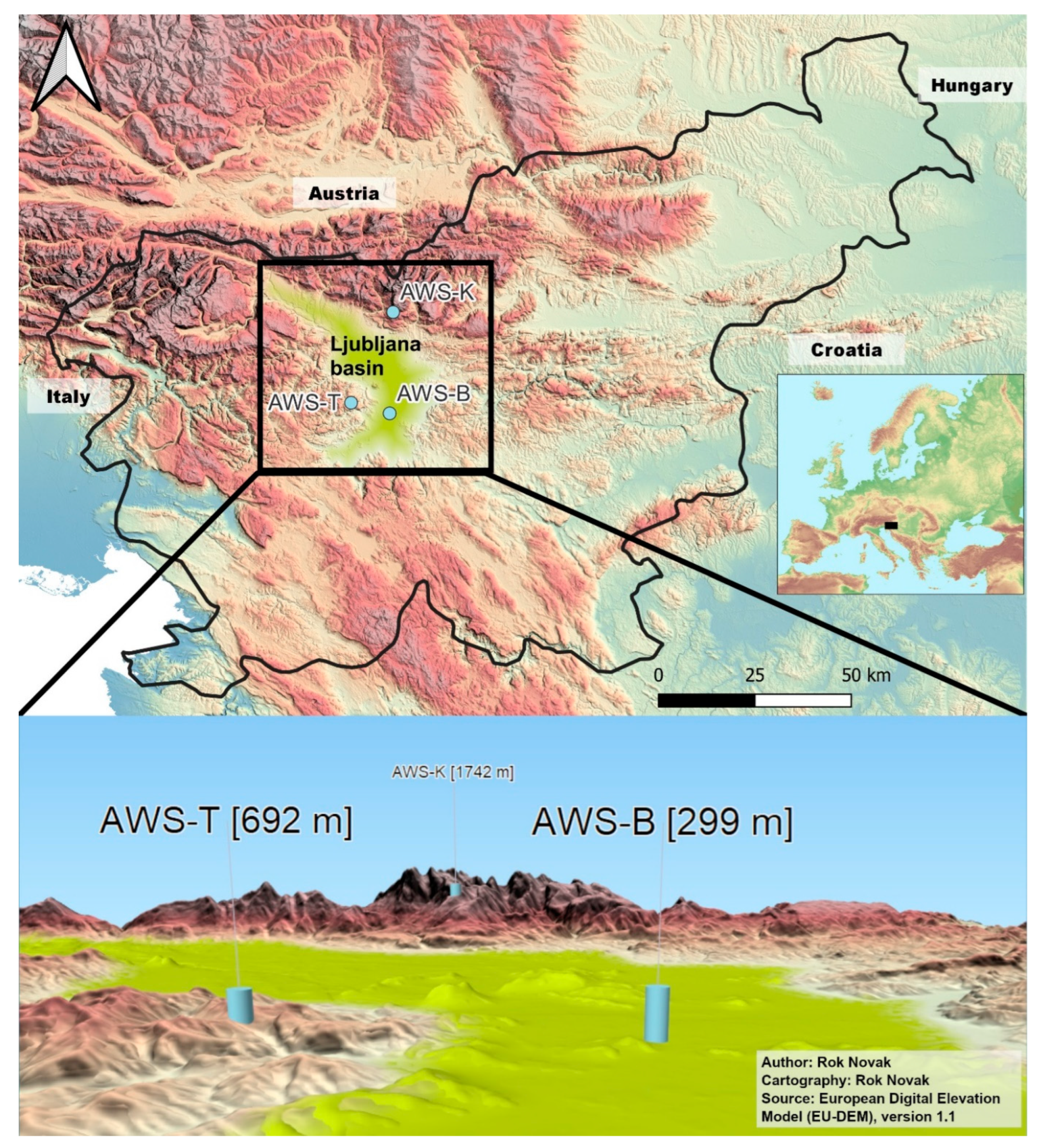
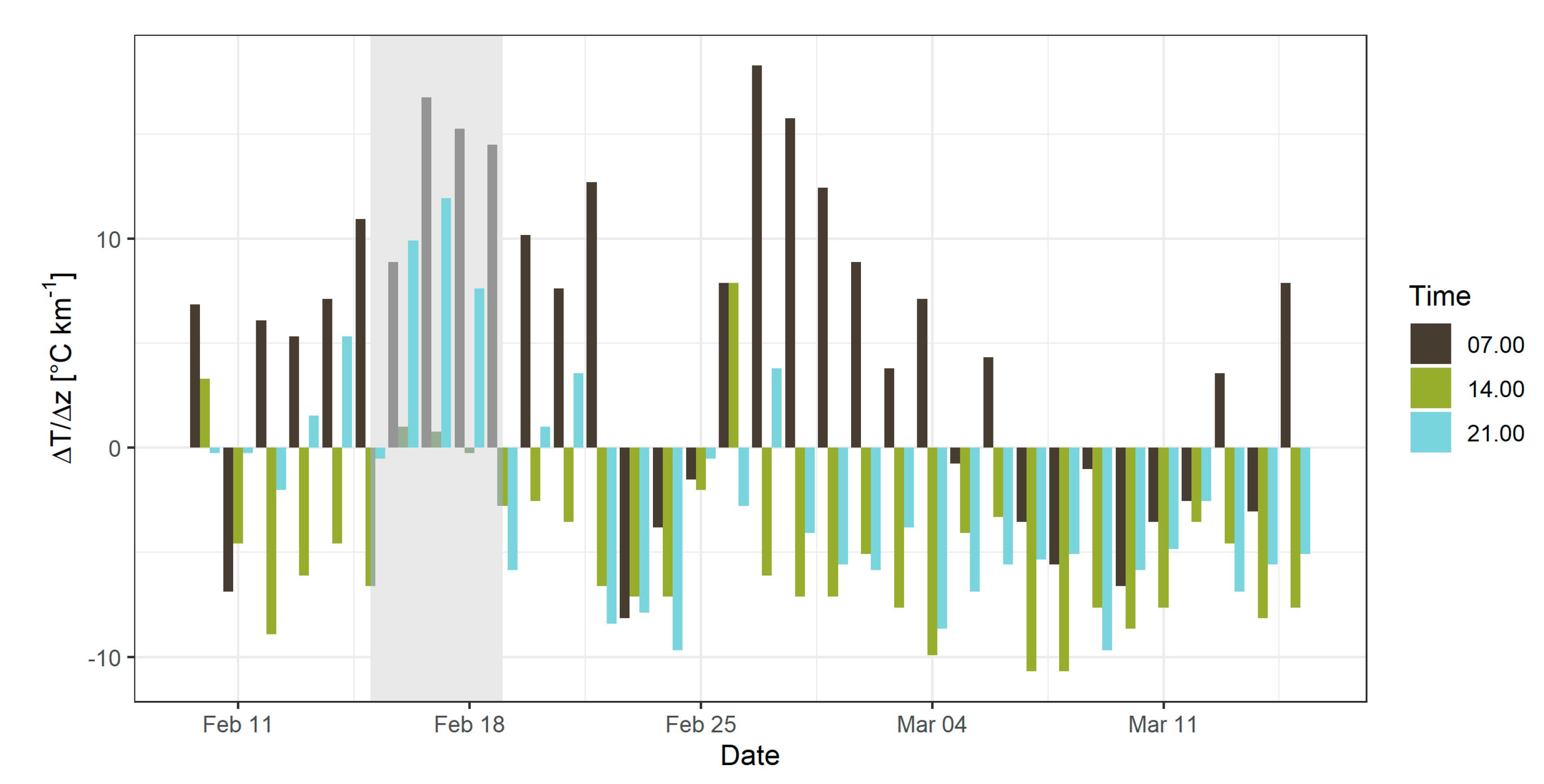
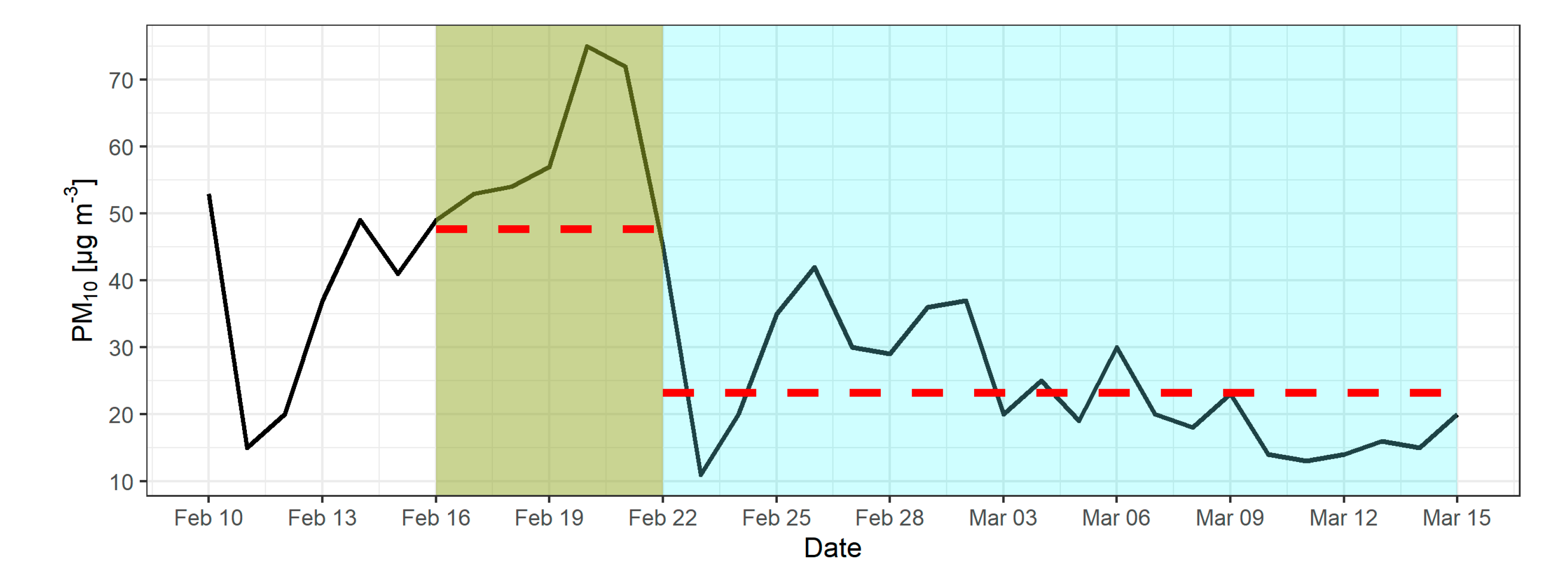
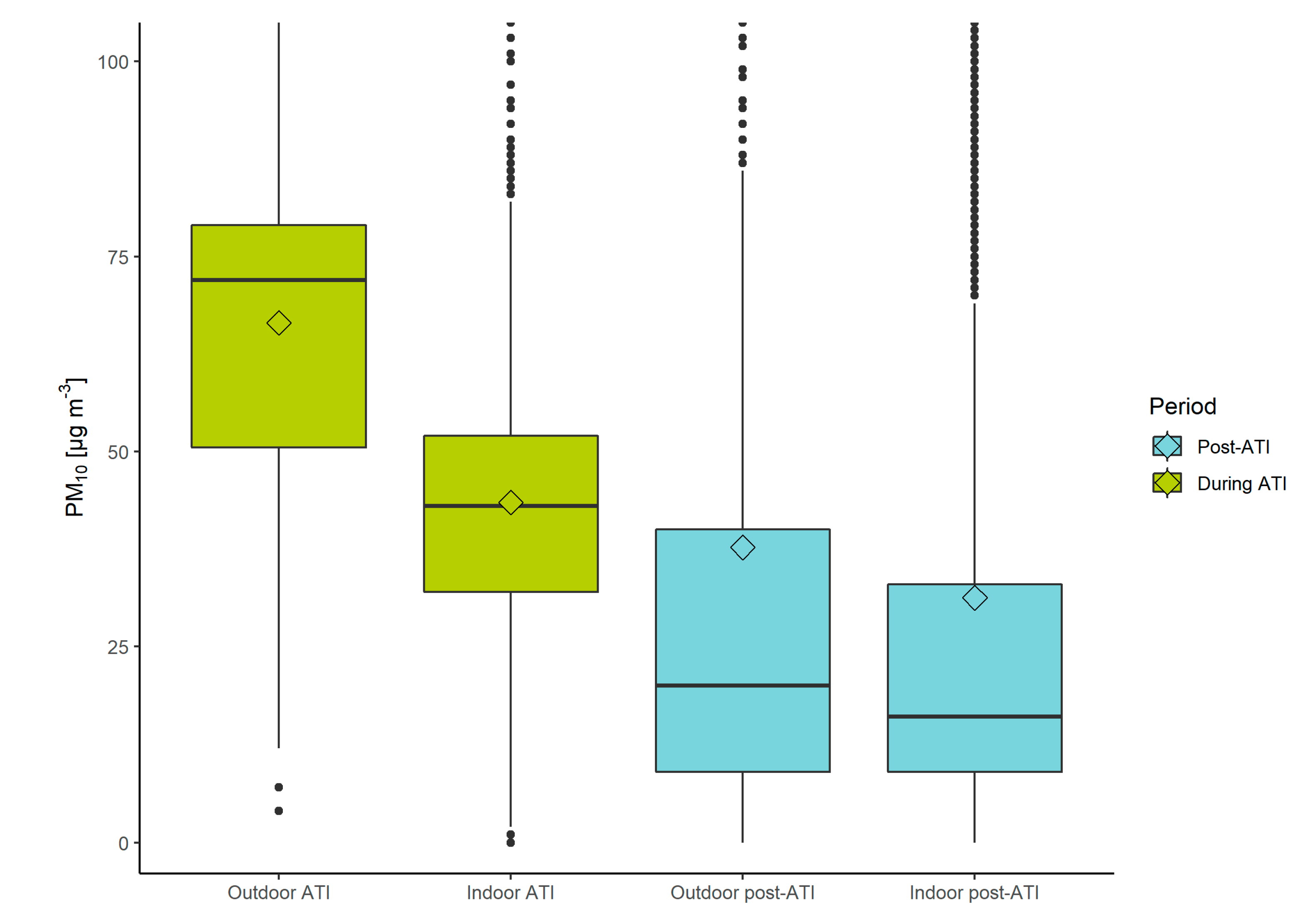
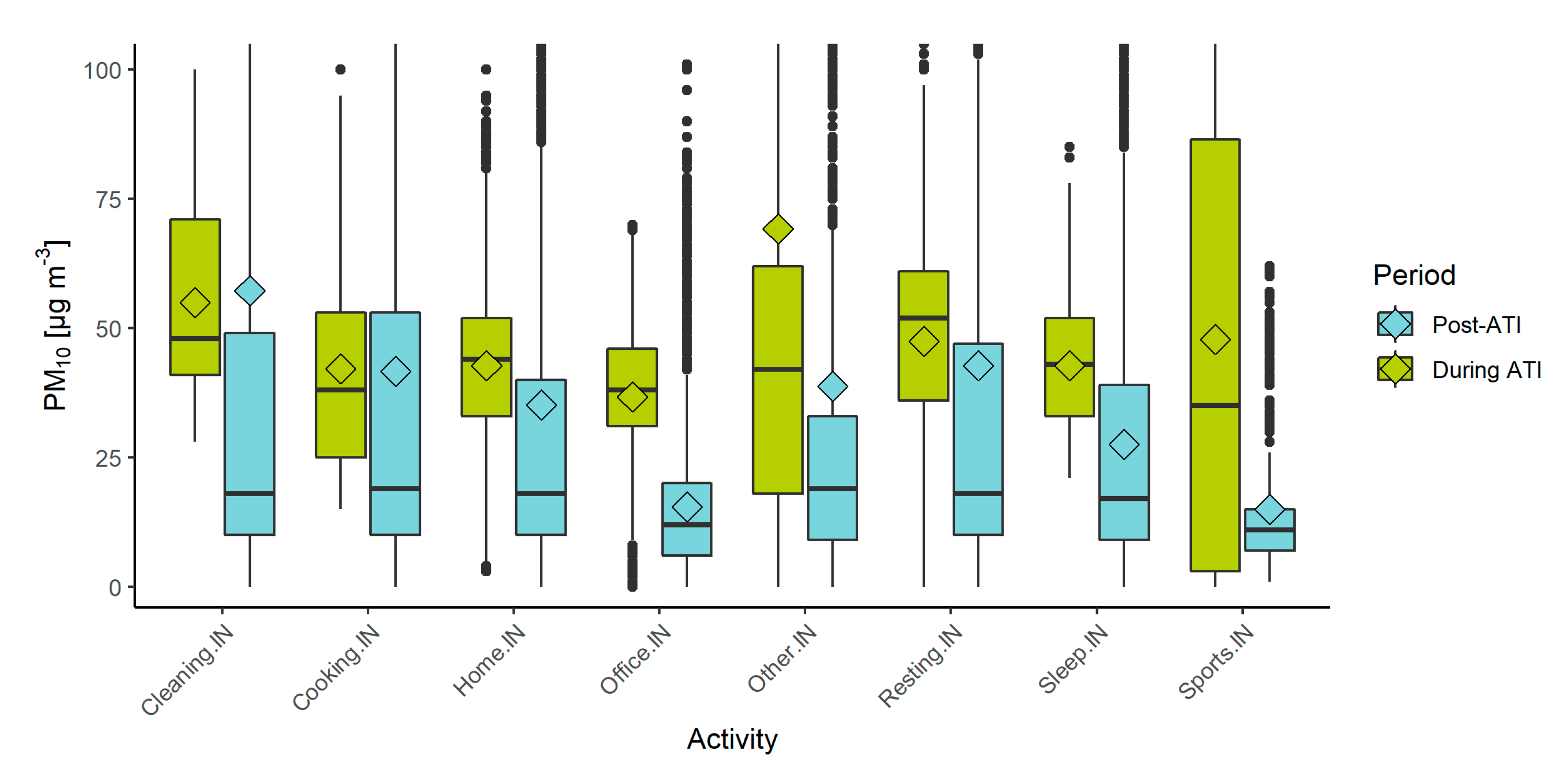

| Station | Meters above Sea Level | Coordinates | Parameters |
|---|---|---|---|
| AWS-B | 299 m | 46.0654 N, 14.5123 E | Temperature, PM10 |
| AWS-T | 692 m | 46.0940 N, 14.3713 E | Temperature |
| AWS-K | 1742 m | 46.2978 N, 14.5335 E | Temperature |
| Period | Cleaning | Cooking | Home | Office | Other | Resting | Sleeping | Sports |
|---|---|---|---|---|---|---|---|---|
| ATI | 395 | 472 | 8535 | 1319 | 632 | 1414 | 3638 | 142 |
| post-ATI | 2060 | 3686 | 41,320 | 11,346 | 4921 | 15,525 | 19,287 | 373 |
| Period | Bicycle | Foot | Home | Office | Other | Running | Sports |
|---|---|---|---|---|---|---|---|
| ATI | 1057 | 538 | 184 | 1170 | 366 | 61 | 295 |
| post-ATI | 1312 | 1822 | 1583 | 967 | 3479 | 294 | 1825 |
Publisher’s Note: MDPI stays neutral with regard to jurisdictional claims in published maps and institutional affiliations. |
© 2022 by the authors. Licensee MDPI, Basel, Switzerland. This article is an open access article distributed under the terms and conditions of the Creative Commons Attribution (CC BY) license (https://creativecommons.org/licenses/by/4.0/).
Share and Cite
Novak, R.; Robinson, J.A.; Kanduč, T.; Sarigiannis, D.; Kocman, D. Assessment of Individual-Level Exposure to Airborne Particulate Matter during Periods of Atmospheric Thermal Inversion. Sensors 2022, 22, 7116. https://doi.org/10.3390/s22197116
Novak R, Robinson JA, Kanduč T, Sarigiannis D, Kocman D. Assessment of Individual-Level Exposure to Airborne Particulate Matter during Periods of Atmospheric Thermal Inversion. Sensors. 2022; 22(19):7116. https://doi.org/10.3390/s22197116
Chicago/Turabian StyleNovak, Rok, Johanna Amalia Robinson, Tjaša Kanduč, Dimosthenis Sarigiannis, and David Kocman. 2022. "Assessment of Individual-Level Exposure to Airborne Particulate Matter during Periods of Atmospheric Thermal Inversion" Sensors 22, no. 19: 7116. https://doi.org/10.3390/s22197116
APA StyleNovak, R., Robinson, J. A., Kanduč, T., Sarigiannis, D., & Kocman, D. (2022). Assessment of Individual-Level Exposure to Airborne Particulate Matter during Periods of Atmospheric Thermal Inversion. Sensors, 22(19), 7116. https://doi.org/10.3390/s22197116









